|
There really is something to be said for the hook of a smartly handled opening scene teaser. I’m not talking about the ones that the horror genre has done to death in recent years, where a generic and nameless individual is killed off by something monstrous or supernatural as a prelude to the dangers that the central characters will later face. No, the scenes I’m thinking of are the ones that are executed with such style that they build instant anticipation for whatever is to follow, my absolute favourite being the glorious opening sequence of Wong Kar-wai’s masterful Chungking Express (Chung Hing sam lam, 1994). I’ll be honest and admit that it’s not something that I expected to see at the front end of an Italian crime thriller, even one directed by genre maestro Fernando Di Leo, and yet here we are with his 1976 Rulers of the City (I padroni della città), and the coolest, most seductive opening scene I’ve watched so far this year.
Two men dressed in work overalls walk into a room from a brightly lit outside location and place a bag on a dining table, which when opened is shown to be full of banknotes, their untidy arrangement suggesting that they are the spoils of a just-committed robbery. One man gleefully shows some of the bills to his appreciative partner, who then walks across the room to a bed in which a young boy is sleeping. As he does so, the first man takes a gun from the bag and shoots him three times, sending him sprawling and waking the boy. The seriously injured but still conscious second man reacts by grabbing a glass from the bedside table and hurling it at his assailant, hitting him squarely in the face and causing him to spin and knock over the bag, scattering the money on the floor. This clearly does some damage but not enough to stop the first man, who responds by unloading another three shots into his former partner, who falls dead to the floor. The boy then gets out of bed and silently checks the fallen man, who we assume is his father, and as the first man kneels down to gather up the fallen money, the boy walks over to the table, picks up the man’s gun and points at his head. Rather than react with alarm, the man grins widely and raises his hands, and it’s at this point that we can clearly see that he’s played by Jack Palance. I mention that because it becomes relevant later. The boy pulls the trigger but the gun is now empty, which prompts the man to laugh and return to the task at hand. When the boy pulls the trigger a second time, the man stands up and swings the money bag at the boy, knocking him out cold. An interesting if straightforward enough opening for a crime thriller that may seem, but what differentiates it from the norm is that the whole scene is shot in silky slow motion and accompanied by Luis Bacalov’s unsettlingly off-key, almost horror-leaning score and select few sound effects. Seriously, you have to see it to appreciate just how beautifully this is handled. Had I popped this disc into my player late one evening to check the quality of the transfer, I know for a fact that I’d have had to stay up to watch the whole film after watching this.
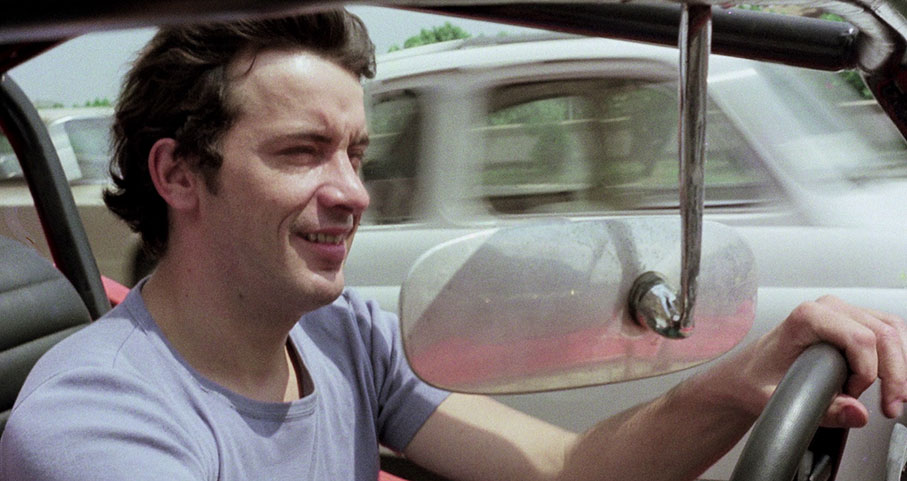
We’re then introduced to our good-looking lead character, Tony (Harry Baer), as he drives through the streets of Rome in a sporty red Beach Buggy, turning the heads of seemingly every attractive woman that he passes while the main titles unfold. He eventually stops off at the stables of a small horse-drawn carriage firm to tell the burly owner (Pietro Ceccarelli) that he has been sent to collect the 30,000 lira that the man owes to local mobster, Luigi Cerchio (Edmund Purdom). The owner tells him to fuck off (his words, not mine) and attempts to throw the less obviously imposing Tony out, but fails to realise that Tony is a former boxer who knows how to handle himself and even have fun doing it. As a result, the man ends up on the floor in a bruised daze and the still cheerful Tony leaves with the money he came for.
At the pool hall in which Luigi and his men hang out, Tony exchanges friendly greetings with several individuals but is mocked and treated with contempt by Luigi’s moustachioed and bulgingly biceped chief enforcer Beppe (Enzo Pulcrano). Tony is keen to climb the enforcer ladder but has yet to convince Luigi that he is capable of more than small-scale debt collecting. An opportunity arises when Peppi scornfully offers to pay him a percentage if he can collect one of his more bothersome debts, a chance that Tony jumps at and unexpectedly delivers on, despite being attacked by three of the debtor’s friends who stupidly mistake this young money collector for an easy mark. He then heads to Luigi’s seedy gambling den, where he hooks up with his best friend, Vincenzo Napoli (Vittorio Caprioli), an old-school gangster who is fond of recalling how they used to do things back in his day. As they chat, a blond-haired man named Ric (Al Cliver) is thrown out for challenging a cheating dealer, despite his protestations that he works for someone named Manzari, aka Scarface. “And I’m Lucky Luciano’s bother,” one of Luigi’s goons mockingly responds before aggressively ejecting him.
When Tony asks Vincenzo if he has any idea how they can make some money, the older man sits him down and berates him for being in so much of a hurry to do so. It’s then that three goons enter the hall and quickly punch its two doorman to the floor. They are followed by an imposing group that includes the previously ejected Ric and the aforementioned Manzari, and given that Manzari is played by Jack Palance, we at least know how he got the facial scar that birthed his street nickname. Instead of busting up the place as expected, Manzari approaches the table from which Ric was ejected, where he plays a quick hand for big stakes and loses, prompting some nervous looks all round. He then claims to be short of ready funds and asks the dealer if he’ll cash a cheque for the entire pot of three million Lira, a request to which the dealer nervously acquiesces. Manzari then picks up the notes and leaves with his entourage, knowing full well that Luigi will not have the nerve to try and retrieve the money or cash this particular cheque. Once outside, Manzari demonstrates his pragmatic ruthlessness by having his men beat the unfortunate Ric senseless for getting ripped off and kicks him out of his organisation. Once Manzari has departed, the injured Ric is lifted from the pavement by a curiously sympathetic Tony, who takes him to his apartment to rest up and recover, telling him to make himself at home before returning to work.
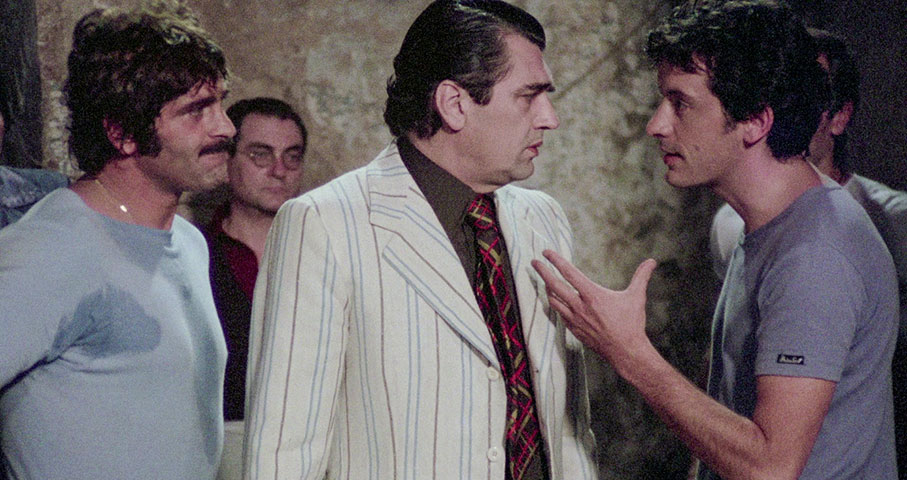
With tensions running high over Manzari’s visit, the perennially upbeat Tony is confronted by an angry Peppi and a fist-fight between them quickly unfolds, one that, against all obvious odds, Tony wins. He then assures Luigi that he can cash Manzari’s cheque, and despite Peppi’s continued mockery, his flustered boss decides to let this young upstart try his luck. There’s just one thing. Having made this boastful claim in an attempt to impress Luigi, Tony actually has no idea how to make good on the promise. As he bemoans his stupidity, however, the partially recovered Ric suggests that may be a way to fleece the money and more from Manzari after all.
It's clear from the early stage that Tony is a hustler looking to climb the criminal ladder, less for the status and power it might bring him than the opportunities it will offer to make some serious lira. Yet there’s initially a suggestion that there’s more to Tony than his opportunistic ambitions, and in order to even touch on that aspect of his character, I’m going to have to add a spoiler warning here. Well, sort of, as what I’m about to discuss will likely to also occur to a good many of those coming to the film for the first time. But if you want to go in cold and decide this for yourself, then skip the next paragraph and you’ll be safe to proceed.
In one sense, the aforementioned opening sequence exists primarily to introduce the film’s principal bad guy, show how cold-hearted and ruthless he is, and establish how he got the scar that gifts him the name by which he will later become widely known and feared. Yet the fact that his murder of his partner was witnessed by the victim’s young son, that this kid did not hesitate to pick up Manzari’s gun and attempt to shoot him, and that Manzari knocked him cold instead of killing him too does leave the way open for a story in which this boy later seeks revenge against Manzari. When this sequence ends and cuts straight to the image of Tony at the wheel of his sporty car, the implication is thus that Tony was the boy in that scene. Sure, save for the shift in style from stylised slow motion to regular speed realism, there are no obvious indicators to establish that time has passed between the two scenes, but the fact that Tony’s story is taking some years later is confirmed when Manzari walks into the gambling den, a former armed robber who has since risen to become the head of a powerful criminal organisation. And yet there’s little about Tony’s behaviour to suggest that revenge of any sort against anyone is even on his radar. Even the plan he hatches with Ric to fleece Manzari of several million lira seems less about sticking it to the gangster than an unexpected opportunity to enrich himself, one that fell into his lap completely through a series of unforeseen chances. By the halfway mark, I was thus becoming convinced that I had been fed and swallowed the reddest of herrings. Or had I? I’m saying no more, but this particular story thread, such as it is, definitely did not unfold as I had predicted.
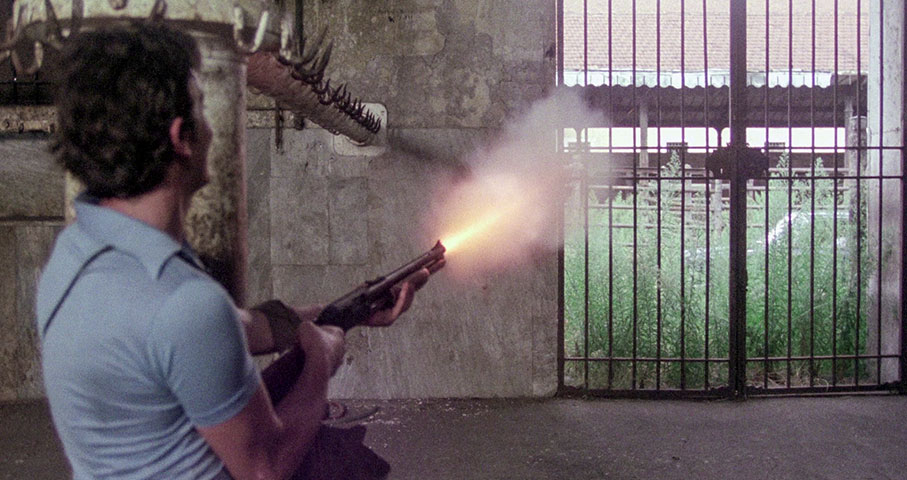
If you’ve seen any of director Di Leo’s previous crime dramas, you’ll be aware that he favours a more realistic, gritty approach to his characters and action, and that’s very much the case here. There’s nothing glamorous about the criminal world in which Tony operates, something clearly visible in the grubby dual locations out of which Luigi operates, and the rag-tag group of individuals he has working for him, down-dressing, wannabe tough guys who are woefully outclassed by the professional thugs that Manzari has in his employ. This approach extends to the action scenes, with fights and gunplay choreographed and performed in a convincingly down-and-dirty manner and filmed with a mixture of observational wide shots, close-ups for impact emphasis, and hand-held coverage that occasional switches to character point-of-view. As a result, the brawls here play as integral narrative beats rather than the show-off action set-pieces. Even the outrageously bold scam that Tony and Ric stage to rob Manzari feels oddly plausible within the context of the narrative and characters, while Tony’s act of cocky foolhardiness at its conclusion is believable in the light of his almost reckless risk-taking and habit of acting on almost egocentric impulse.
The specifics of how the story unfolds from this point on are not for me to reveal here, but they do include a sudden and violent power grab that really caught me out, and it should come as no surprise that the scam pulled by Tony and Ric sparks a violent retaliatory response from Manzari. This leads to both men being forced to take refuge with the displeased Vincenzo, a proud old-school gangster whose subsequent brazen show of defiance in the face of Maznari’s lethal threats puts Tony’s earlier cockiness to shame. As the situation complicates for Tony, it becomes increasingly clear that he’s way out of his depth, and despite some questionable decisions on his part, I found myself really rooting for him, which made Manzari’s determination to make him and his friends pay for his crime with their lives all the more tense. Yes, we know he can handle himself in a fist fight, but he’s up against a small army of professional mafia goons with guns, and is thus very much the underdog in the film’s second half. He’s fortunate to have fallen in with Ric, who as a former Manzari employee seems to know how to handle himself in a pinch, and Vincenzo has been in the game long enough to have a small stash of weapons tucked away and experience in their usage, but the odds are still stacked heavily against this oddly likeable trio.
There are a small handful of conceits to movie convention here in the shape of silencers that ensure pistols barely make a sound, cars that explode in a fireball when shot, and the dangerous suggestion that jumping through a closed window will not result in even the smallest cut or scratch from the shattered glass (don’t do it, kids!). The low angle shots of the gyrations of a semi-naked black dancer that serves as our introduction to the nightclub run by Luigi’s girlfriend Clara (Gisela Hahn) – who also has a thing for Tony, of course – also lingers way beyond what the scene requires, but were doubtless appreciated by (male) audiences back in the 70s. For the most part, however, Di Leo keeps the storytelling tight and the action grounded. He’s ably served here by a trio of engagingly diverse performances from Harry Baer as the cheerfully impulsive Tony, Al Cliver as the more cooly restrained Ric, and Vittorio Caprioli as the colourfully expressive Vincenzo. With his chiselled features and icy stare, Palance is nicely cast as Manzari, his almost demonic smile in the opening scene giving way to his unfazed confidence as the leader of the city’s most dangerous criminal gang. The muscular Enzo Pulcrano makes for an imposingly tough Beppe, Gisela Hahn exudes a nicely European allure as the blonde-wigged Clara, and I did like Carmelo Reale as Manzari’s largely silent second-in-command, Luca, whose suspicious and accusatory stares negate the need for explanatory dialogue. I’ll also give a shout out for cinematographer Erico Menczer’s naturalistic lighting and purposeful framing, as well as Di Leo regular Amedeo Giomini’s sharp editing, which ups the pace of the action without descending into the confusing barrage of shots that blight so many such scenes in more recent films.
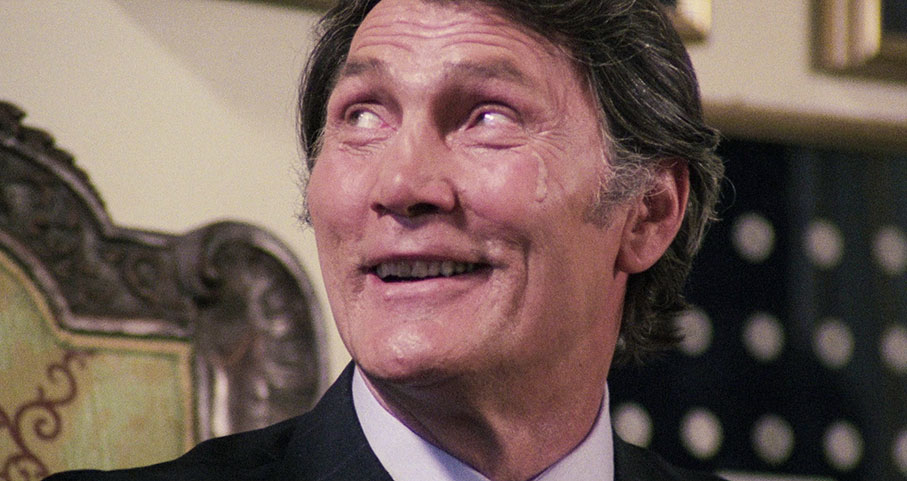
The more Fernando Di Leo films I see, the more I hope that Radiance continues to source and release his work on Blu-ray, and with the news that his enticingly titled 1974 poliziotteschi Shoot First , Die Later (Il poliziotto è marcio) is coming to the label in May, it looks very much like my wish will be granted. If the high watermark for Di Leo was set by his Milieu Trilogy – Milano Calibro 9 (1972), The Italian Connection (La mala ordina, 1972), and The Boss (1973) – Rulers of the City comes a very close second, and in terms of its characters and performances and its sometimes twisty narrative development, it’s absolutely their equal. I may have questions about the plausibility of the trap that sets up the action-driven climax, and there’s a sense that one car is driving round the site in circles at high speed primarily to keep the pace from dropping. In all other respects, however, it’s a tense and action-packed finale, one whose outcome for everyone involved remains uncertain right up to the satisfying final payoff. Chalk another win up for genre maestro Di Leo.
Sourced from a 2020 4K restoration of the original negative, the 1080p transfer on Radiance’s Blu-ray, framed in the film’s original aspect ratio of 1.85:1, is in deceptively excellent shape. I say deceptively because the film’s use of naturalistic lighting, unflashy and sometimes even dour locations, and workaday costumes, mean that colours do not exactly leap from the screen, but I have little doubt that this was always the intention. Indeed, the Di Leo’s emphasis on visual realism and presenting the underworld in an unglamorous light is handsomely captured here, and while there is a very slightly earthy tone to many scenes, the more distinct colours that do appear are pleasingly reproduced without feeling remotely oversaturated. The image is sharp with clearly defined detail, save for three or four shots with the focus appears to have been a slightly off at the shooting stage, and a small number of slightly jittering shots aside, the picture is stable in frame. It’s also almost completely clean of dust and any former wear – only on a few frames did I spot small blips of damage. Very nice.
Both the original Italian soundtrack and the English language track found on the print used for distribution in North America (where the film was clunkily retitled Mister Scarface) are presented here as Linear PCM 2.0 mono tracks, and which one you select really will be down to personal preference. In common with almost all Italian genre films of the period, Rulers of the City was shot silent and post-dubbed in both languages, a practice that made it easy to have actors from Germany (Harry Baer, Gisela Hahn), Egypt (Al Cliver), Britain (Edmund Purdom) and America (Jack Palance) appearing to speak fluently in both languages, even if their words are sometimes mismatched with the movements of their mouths. If you want to hear Jack Palance speaking in his own voice, then the English language track is definitely the way to go, and it does look like Baer and Cliver were filmed delivering their lines in English too. Having said that, I tended to prefer the more committed dialogue delivery Italian track – Tony and Ric sound a tad too much like the post-dubbed voices that they are on the English language track, and there’s more that a whiff of Nintendo’s Mario and Luigi to the revoiced Vincenzo.
Optional English subtitles are activated by default if you select the Italian language track, and optional English subtitles for the hearing impaired are also available and can be activated for either track. In one small bit of Anglicisation I did notice, the name ‘Ric’ is spelt ‘Rick’ on the SDH subtitles.
Violent City (15:32)
A 2004 featurette on Rulers of the City that I presume was sourced from an earlier American DVD release (the fixed English subtitles refer to the film under its American title), one built around interviews with four of the key personnel involved in its making. Actor Al Cliver recalls it being a fun film to make, that director Di Leo was like “an English gentleman” on set and in real life and ensured that they finished filming by 4pm each day, and that fellow actor Harry Baer spent a week in hospital after being accidentally shot in the eye with a blank round. He is also full of praise for the stunt team and one motorcycle stunt rider in particular. Director Fernando Di Leo, in an amalgamation of two sperate interviews, reveals that the reason they finished early each day is that he makes a point of never working evenings or nights. He also remembers butting heads with Jack Palance because he would not follow a specific direction, and claims that he helped improve him as an actor. Editor Amedeo Giomini reveals that Harry Baer had “terrible haemorrhoids” whilst filming and couldn’t sit down, which proved a painful challenge for the shots when he had to jump into the seat of his open-topped Beach Buggy. Finally, the film’s weapons expert Gilberto Galimberti is on hand to briefly outline his role, then bemoan the fact that his contribution is largely unsung and forgotten as soon as the film is complete.
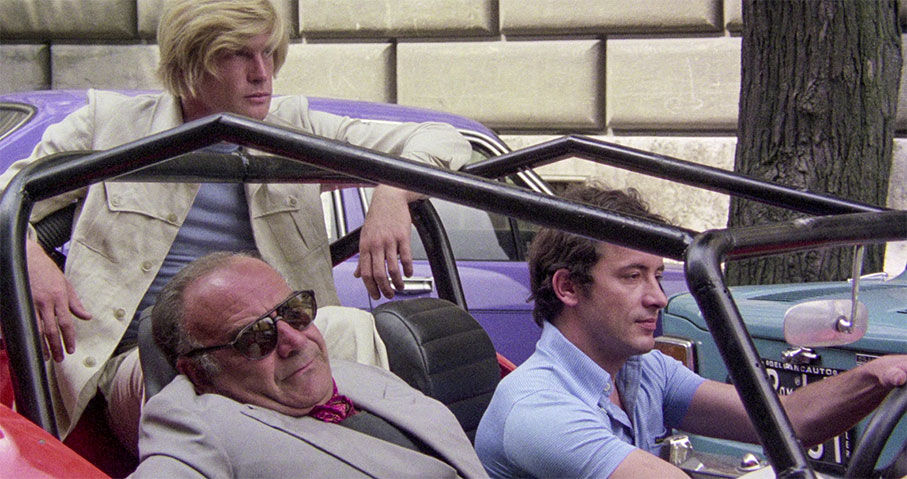
Video Essay (13:06)
A personal rule that I have when reviewing discs is that I list the special features not as they appear on the press release or the packaging of the disc, but as they are titled on the special features menu. Not this time. This video essay by Mike Malloy kicks off with an almost cynical “Yeah, spoilers” caption, but if you’re relatively new to Italian crime movies, even the true title of this video essay will count as a spoiler, which is why I’ve elected not to include it here and why I’m going to be a little coy about its content. Thankfully, the two on-disc special features here are tucked away behind a ‘Supplements’ sub-menu, which I’d strongly advise not clicking on until after you’ve seen the film. Then again, you shouldn’t really watch any supplementary features until after you seen the movie they’re discussing. Anyway, back to the subject at hand. Announcing himself here as “a tough guy film expert,” – and make no mistake, this man really knows his subject – Malloy’s focus here is the self-named subgenre that is the true title of this essay and to which he believes Rulers of the City belongs. He also cites other notable examples from a variety of primary genres, and makes good on that opening caption by discussing ways in which this film both conforms to and kicks against the tropes of this subgenre. It’s persuasively argued, though does end on a promo for Malloy’s other contributions to Blu-ray special features.
Also included is a Limited Edition Booklet with new writing by Francesco Massaccesi, but this was not available for review.
Another top-notch crime drama-thriller from genre specialist Fernando Di Leo is getting its UK Blu-ray premiere here on Raro Video via Radiance, a label that has already done a bang-up job of introducing many of us to this distinctive and accomplished filmmaker’s work. A fine restoration and HD transfer is supported by just two on-disc special features, but both are worthwhile (after you’ve watched the film itself, of course), and if you get the release disc, you will also have the booklet essay that I’ve not got my hands on yet. If you’ve seen and enjoyed the Milieu Trilogy, then this Blu-ray is an absolute must-have, and if you’ve so far not sampled the gritty delights of Di Leo’s genre cinema, this is as good as any place to start. Warmly recommended.
|